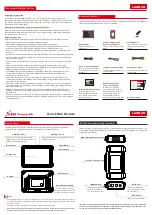
Rev 5.0/2-21
MRTA8-DC3: #35121AUS
31
T
ESTING
Perform the following test to determine whether or not a load surface is too porous or rough:
Lifter/Load Compatibility Test
1
1) Make sure the vacuum generating system is functioning correctly (see
2) Thoroughly clean the load surface and the vacuum pads (see
).
2
3) Place the load in the upright position on a stable support.
4) Attach the vacuum pads to the load as previously directed.
5) After the vacuum pump stops running, hold the “function” button (
) and the “power”
button (
) for at least 5 seconds to power down the vacuum lifter.
Note: During this time the LCD screen displays “WARNING! Is load attached?”, the
notification buzzer chirps rapidly and the strobe light flashes.
6)
Take precautions in case
load should fall during test.
Raise the load a minimal distance, to make sure it
is supported by the lifter.
7) Watch each vacuum gauge:
Starting from a
vacuum level of 16" Hg [-54 kPa], the lifter must maintain a vacuum level greater than
12" Hg [-41 kPa] for 5 minutes.
If not, lifting this load requires additional precautions (eg,
a load sling). Contact WPG for more information.
8) Lower the load
after
5 minutes or
before
the vacuum level diminishes to 12" Hg [-41 kPa].
1..... The
“Pad-to-Load Friction Coefficient”
can affect the outcome of this test.
2..... Contaminated loads can also cause the vacuum pump to run frequently or continuously. Since excessive pumping quickly reduces battery
energy, clean the load whenever possible.
INSPECTIONS AND TESTS
















































